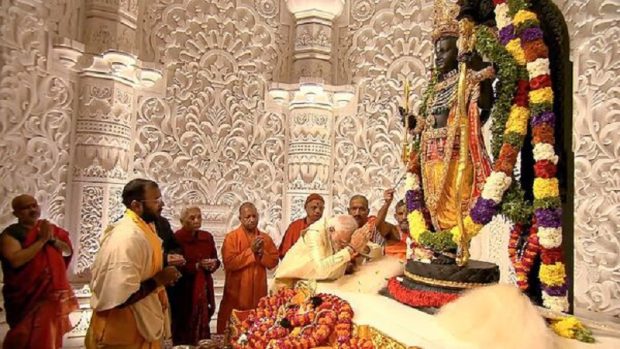
All set for ‘Surya tilak’ of Ram Lalla in Ayodhya on Ram Navami
PTI, Apr 16, 2024, 8:37 PM IST

Representative image (source: PTI)
Lucknow: At noon on Ram Navami Wednesday, the Sun’s rays will fall on the forehead of Ram Lalla in Ayodhya, a ‘Surya tilak’ of the deity made possible by an elaborate mechanism involving mirrors and lenses.
This would be the first Ram Navami since the consecration of the Ram idol at the new temple, inaugurated by Prime Minister Narendra Modi on January 22.
The system was tested by the scientists on Tuesday.
“The basic objective of the Surya Tilak project is to focus a ’tilak’ on the forehead of Shri Ram idol on every Shri Ram Navami day. Under the project, sunlight will be brought on the forehead of Lord Ram at noon on Shri Ram Navami in the Chaitra month every year,” Dr S K Panigrahi, scientist at CSIR-CBRI Roorkee, who was associated with the project told PTI.
Elaborating further, Panigrahi said, “The position of the Sun changes every year on the day of Shri Ram Navami. Detailed calculations show that the date of Shri Ram Navami repeats every 19 years.”
According to a senior scientist of Council of Scientific and Industrial Research (CSIR)-Central Building Research Institute (CBRI), Roorkee, the planned tilak size is 58 mm. The exact period of tilak on the forehead centre is about three to three-and-a-half minutes, with two minutes of full illumination, he said.
Meanwhile, a member of Shri Ram Janmabhoomi Teerth Kshetra Trust, Anil Mishra, told PTI, “During the Surya tilak, devotees will be allowed inside the Ram temple. Around 100 LEDs are being put up by the temple trust, and 50 by the government, which will show the Ram Navami celebrations. People will be able to see the celebrations from where they are present.”
Sharing his personal experience in installing this unique mechanism, Dr D P Kanungo, chief scientist at CSIR-CBRI, Roorkee said, “Actually this is meticulously planned, designed and implemented to achieve utmost accuracy.”
This will be a testament to our scientific acumen and indigenous technological development to showcase before our countrymen who have all the faith in and support to our scientific community, he said.
Asked what will happen to Surya tilak in case of a cloudy sky, Kanungo said, “That’s the limitation. We don’t wish to do with artificial light because of the faith and belief of our people.”
In consultation with the Indian Institute of Astrophysics (IIA), Bangalore, the CSIR-CBRI, Roorkee team has developed a mechanism for a 19-year period to steer the sunlight from the third floor of the temple to the ‘garbha griha’.
The detailed complete design to bring the sunlight to the garbha griha is developed by CBRI, with the IIA providing consultancy for the optical design.
The fabrication of optical elements, pipes, tilt mechanism and other related components are carried out by Optics and Allied Engg Pvt Ltd (Optica), a Bangalore-based company.
Before implementing the opto-mechanical system in the Ram temple for Surya tilak, a scaled down model suitable for the Roorkee locality has been successfully validated. A full scale model has been successfully validated at Optica site at Bangalore in March 2024.
The CSIR-CBRI, Roorkee team along with IIA Bangalore and Optica Bangalore completed the installation in the first week of April, and repeated trials have been done, Panigrahi said.
Meanwhile, explaining the opto-mechanical system for Surya tilak, Panigrahi said, “The opto-mechanical system consists of four mirrors and four lenses fitted inside the tilt mechanism and piping systems. The complete cover with aperture for the tilt mechanism is placed at the top floor to divert the Sun rays through mirrors and lenses to the garbha girha.”
“The final lens and mirror focus the Sun rays to the forehead of Shri Ram facing towards the east. The tilt mechanism is used to adjust the first mirror tilting for sending the Sun rays towards the north direction to the second mirror for making the Surya tilak every year on Shri Ram Navami day,” he said.
“All the piping and other parts are manufactured using the brass material. The mirrors and lenses which are used are of very high quality and durable to sustain for a long period.
“The inner surface of pipes, elbows and enclosures are black powder coated to avoid scattering of sunlight. Also at the top aperture, IR (infra red) filter glass is used to restrict the Sun heat wave to fall on the forehead of the idol,” Panigrahi said.
He said the team from CSIR-CBRI Roorkee includes Dr S K Panigrahi, Dr R S Bisht, Kanti Solanki, V Chakradhar, Dinesh and Sameer. Prof R Pradeep Kumar (Director, CSIR-CBRI) mentored the project.
From IIA Bangalore side, Dr Anna Purni S (Director IIA), Er S Sriram and Professor Tushar Prabhu are the consultants. Rajinder Kotaria, managing director, Optica, and his team Nagraj, Vivek, Thava Kumar were actively involved in fabrication and installation part.
Udayavani is now on Telegram. Click here to join our channel and stay updated with the latest news.
Top News

Related Articles More

Blocked 18 OTT platforms for publishing obscene, vulgar content: Govt

Congress claims party worker ‘died due to tear gas smoke’ during protest in Assam

Rajasthan govt to replace Urdu terms in policing with Hindi words

Congress twisted facts, distorted my statement on Ambedkar: Amit Shah

One dead, 66 rescued after ferry capsizes off Mumbai coast
MUST WATCH
Latest Additions

Assembly clears Mysuru Development Authority Bill

Blocked 18 OTT platforms for publishing obscene, vulgar content: Govt

Boy critically injured after tree branch falls on him in Bengaluru

Congress claims party worker ‘died due to tear gas smoke’ during protest in Assam

Four dead in road accident in Kolar
Thanks for visiting Udayavani
You seem to have an Ad Blocker on.
To continue reading, please turn it off or whitelist Udayavani.


















